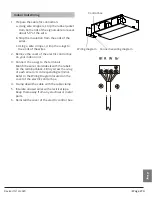
NOTE:
1. Do not place the connecting duct weight
on the indoor unit.
2. When connecting the duct, use an
nonflammable canvas tie-in to prevent
vibrating.
3. Insulation foam must be wrapped outside
the duct to avoid condensate. An internal
duct underlayer can be added to reduce
noise, if the end-user requires.
NOTE: All the figures in this manual are for
demonstration purposes only. The air con-
ditioner you have purchased may be slightly
different in design, though similar in shape.
Indoor Unit
Installation
Page 19
Revised 5/14/2020
Step 3: Duct and accessories installation
1. Install the filter at the register for
maintenance access, or on the unit if direct
return.
2. Install field-supplied fiberboard supply and
return plenums (if any).
3. The air inlet and air outlet duct should be far
enough apart enough to a avoid air passage
short-circuit.
4. Connect the duct according to the following
diagram:
5. Refer to the following static pressure
guidelines when installing the indoor unit.
Step 4: Instructions for converting from rear
air return to bottom air return
1. Take off the ventilation panel and flange.
Bend the rear ventilation panel 90 degrees along
the dotted line into a descending ventilation
panel. (some models)
2. Change the mounting positions of the
ventilation panel and air return flange.
3. When installing the filter mesh, fit it into the
flange as illustrated in the following figure.
Canvas tie-in Canvas tie-in
Air outlet
Isolation booth checking orifice
Isolation booth
Air inlet
Air dust filter
MODEL
(Btu/h)
Static Pressure
(in.wg)
12k
0~0.2
18k
0~0.4
Change the fan motor static pressure according
to external duct static pressure.
Ventilation panel
Air return flange
Ventilation panel
Air return flange
Air return flange
Ventilation panel
Or





































